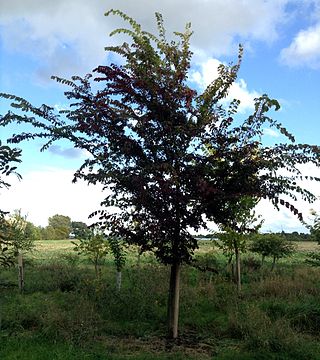Related Research Articles

Ulmus 'Frontier' is an American hybrid cultivar, a United States National Arboretum introduction derived from a crossing of the European Field Elm Ulmus minor with the Chinese Elm Ulmus parvifolia in 1971. Released in 1990, the tree is a rare example of the hybridization of spring- and autumn-flowering elms. Tested in the US National Elm Trial coordinated by Colorado State University, 'Frontier' averaged a survival rate of 74% after 10 years.
Ulmus 'Morton Plainsman' is a hybrid cultivar raised by the Morton Arboretum from a crossing of Siberian Elm and a Japanese Elm grown from openly pollinated seed donated by the Agriculture Canada Research Station at Morden, Manitoba. Tested in the US National Elm Trial coordinated by Colorado State University, Vanguard averaged a survival rate of 78% after 10 years.

Ulmus 'Morton Red Tip' is a hybrid cultivar raised by the Morton Arboretum from an open pollination of Ulmus 'Morton'. The tree has occasionally been reported as a hybrid of Accolade with the Siberian Elm Ulmus pumila, an error probably owing to the commercial propagation of the tree by grafting onto U. pumila rootstocks. Tested in the US National Elm Trial coordinated by Colorado State University, Danada Charm averaged a survival rate of 77.5% after 10 years.
The Chinese Elm cultivar Ulmus parvifolia 'Burgundy' was selected for its autumn foliage by Dr Michael Dirr and A. E. Richards from a tree on the University of Georgia campus, and first described in 1990.

Ulmus parvifolia 'Emer II' or 'Emerald Vase' is a Chinese Elm cultivar selected by Dr. Michael A. Dirr and cloned in the late 1980s from a tree planted circa 1910 on the University of Georgia campus at Athens, that had survived ice-storms undamaged. It was patented in 1991.
The Chinese Elm cultivar Ulmus parvifolia 'Emer I' or 'Emerald Isle' was cloned from a tree planted circa 1920 on the University of Georgia campus at Athens.
The Chinese Elm cultivar Ulmus parvifolia 'Dynasty' is a United States National Arboretum introduction resulting from a controlled crossing of two trees of Korean origin. First described in 1984, it is reputed to be very fast-growing.
The Chinese Elm cultivar Ulmus parvifolia 'Hallelujah' is one of three American introductions made circa 1992 that were selected for their cold hardiness. 'Hallelujah' is known to have withstood -37 °C (-35 °F) in Missouri. The tree was first listed by the Arborvillage Nursery, Holt, Missouri, in its 1993–1994 catalogue.

The Chinese Elm cultivar Ulmus parvifolia 'King's Choice', patented in 1985, is one of the early American selections best known for its winter hardiness, being able to withstand temperatures of -30 degrees Celsius. It was originally selected for its "outstanding growth ".

The Siberian elm cultivar Ulmus pumila 'Hansen' is a little-known American tree, raised from seed collected by the horticulturist and botanist Prof. Niels Hansen during his expedition to eastern Siberia in 1897, and further developed in South Dakota.

The Chinese Elm cultivar Ulmus parvifolia 'Seiju' is a dwarf variety, a sport of 'Hokkaido'.

The Chinese Elm cultivar Ulmus parvifolia 'Yatsubusa' is a dwarf variety.
The American Elm cultivar Ulmus americana 'Jackson' was cloned c.1990 from an elm selected at Wichita, Kansas, which had reputedly shewn no signs of Dutch elm disease damage at over 50 years of age.
The Chinese Elm cultivar Ulmus parvifolia 'Elsmo' was released by the USDA Soil Conservation Service, at Elsberry, Missouri, in 1990 as an open-pollinated, seed-propagated cultivar of extremely variable progeny.
The Chinese Elm cultivar Ulmus parvifolia 'Garden City Clone' was raised in Kansas. The champion tree was 18 m tall in 1993; however, the name 'Garden City Clone' is not officially recognized.
The Chinese Elm cultivar Ulmus parvifolia 'Red Fall' is an American clone selected by S. Bieberich of the Sunshine Nursery, Clinton, Oklahoma.
The Chinese Elm cultivar Ulmus parvifolia 'State Fair' was cloned from a tree growing in the grounds of the Oklahoma State Fair, Oklahoma City.
The Chinese elm cultivar Ulmus parvifolia 'The Thinker' was selected by M. Hayman from a tree on the campus of the University of Louisville, Kentucky.
The Chinese elm cultivar Ulmus parvifolia 'Orange Ribbon' was tested in the United States for cold-hardiness. The name is considered invalid by some, for want of fuller description.
The Chinese Elm cultivar Ulmus parvifolia 'Select 380' was tested in the United States for cold-hardiness. The name is considered invalid by some for want of fuller description.
References
- ↑ Santamour, Frank S.; Bentz, Susan E. (May 1995). "Updated Checklist of Elm (Ulmus) Cultivars for use in North America". Journal of Arboriculture. 21 (3): 122–131. Retrieved 20 June 2016.
- ↑ "Ulmus parvifolia 'Glory' (Lacebark Elm) Further Reading". Zip Code Zoo. Retrieved 27 August 2011.
- 1 2 U. parvifolia 'Glory', Dawes Arboretum; dawesarb.arboretumexplorer
- 1 2 Gilman, Edward F.; Dennis G. Watson. "Ulmus parvifolia" (PDF). Fact Sheet. United States Forest Service. Retrieved 3 September 2012.
- ↑ Bieberich, Steve. "Elm Leaf Beetle Survey". Sunshine Nursery. Steve Bieberich. Retrieved 27 August 2011.